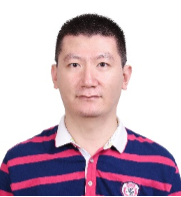
Prof. Wenbo Peng
Xi’an Jiaotong University, China
Title: Piezo-Phototronic Effect in Multi-Layer Structured Optoelectronic: Bilateral Piezoelectric Charge Modulation
Abstract:
Piezo-phototronic
effect utilizes the strain induced piezoelectric charges inside the
piezoelectric semiconductors to modulate the local energy band diagram at the
interface of junctions, thus controlling the photo-generated carriers’
behaviors and the performance of optoelectronic devices. Since its invention in
2010, piezo-phototronic effect is vastly demonstrated in photodetectors,
light-emitting diodes, and solar cells, where only one interface is modulated
by piezoelectric charges. In 2018, we first propose to construct multi-layered
structure for efficient utilization of piezoelectric charges with both
polarities and obtain better performance optimization by piezo-phototronic
effect [1], which we recently name as Bilateral
Piezoelectric Charge Modulation [2]. Here, we summarize the recent progresses of our researches on
bilateral piezoelectric charge modulation, including both experimental results
and analytical theories.
An
n-ZnO/p-Si/n-ZnO double heterojunction bipolar phototransistor is designed, and
the regulation of bilateral piezoelectric charges on bipolar phototransistor’s
performances is studied from the perspectives of theoretical derivation and
experimental research simultaneously. A theoretical model of n-ZnO/p-Si/n-ZnO
double heterojunction bipolar phototransistor is established, and the influence
of four polar combinations of piezoelectric charges induced by different
strains formed at the interface of two heterojunctions on the characteristics
of phototransistor is carefully studied. The theoretical calculation results
show that, when positive piezoelectric charges are generated at both two
interfaces, the regulation of strain on the phototransistor is a superposition
of two positive effects, which can significantly improve the performances of phototransistor.
Then an n-ZnO/p-Si/n-ZnO double heterojunction bipolar phototransistor is
experimentally prepared. By rationally designing the device structure, positive
piezoelectric charges could be simultaneously generated at the two heterojunction
interfaces when an external compressive strain is applied. The saturation
current of phototransistor is significantly improved, and the photoresponsivity
is also improved to a certain extent by the applied compressive strain. To
further optimize the performances, the effects of interdigitated electrode’s
size, substrate and ZnO layer on the strain regulation of device performance are
carefully studied. The experimental results show that when the p-Si substrate
is used, the size of interdigitated electrodes is chosen as channel width W0 = 80 μm, the channel
length L = 5 μm, and the number of
electrodes N = 14, and the ZnO
nanowires layer prepared by low temperature hydrothermal growth method is used
as both emitter and collector, the strain induced bilateral piezoelectric
charges regulation of the obtained bipolar phototransistor is the best. At a
compressive strain of -1.37%, the photoresponsivity is enhanced about 2000%,
indicating the significant modulation of applied strain on the performances of
heterojunction bipolar phototransistor.
Keywords
Piezo-Phototronic;
Heterojunction Bipolar Phototransistor; Bilateral Piezoelectric Charge
Modulation
References
[1]
Fangpei Li, Wenbo Peng, Zijian Pan, Yongning He, Optimization of
Si/ZnO/PEDOT:PSS tri-layer heterojunction photodetector by piezo-phototronic
effect using both positive and negative piezoelectric charges, Nano Energy,
2018, 48, 27-34.
[2]
Fangpei Li, Wenbo Peng, Yongning He, Bilateral piezoelectric charge modulation
as a perspective of piezo-phototronic effect in tri-/multi-layer structured
optoelectronics, Nano Energy, 2023, 113, 108537.
Biography:
Dr. Wenbo Peng is now an Associate Professor at School of Microelectronics, Xi’an Jiaotong University. He received his PhD degree in major of Electronic Science and Technology at 2016 and bachelor degree in major of Microelectronics at 2010, from Xi’an Jiaotong University. He has been a visiting scholar in School of Materials Science and Engineering, Georgia Institute of Technology from Aug 2014 to Jul 2016, working on the research fields of piezotronics and piezo-phototronics under the supervision of Prof. Zhong Lin Wang.
His research interests mainly focus on advanced low dimensional piezoelectric semiconductor materials, devices and physics, and novel intelligent sensing integrated chips. He has received several fundings from NSFC, Shaanxi Province and companies. He has authored and co-authored over 50 peer-reviewed journal publications in related research fields, parts of which are published on high quality international journals, including Advanced Materials, Advanced Functional Materials, Advanced Energy Materials, Nano Energy, ACS Nano, Nano Letters, etc. His publications have been cited over 2400 times, as documented at Google Scholar (h-index: 26). He has given several Keynote/Distinguished/Invited Talks in renowned international conferences. He is the Fellow of International Association of Advanced Materials.